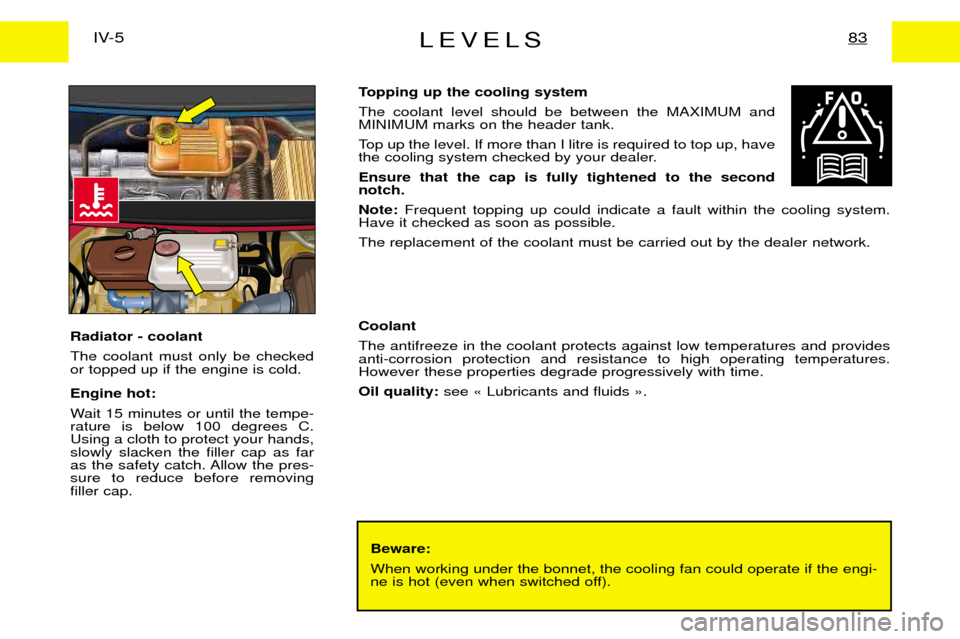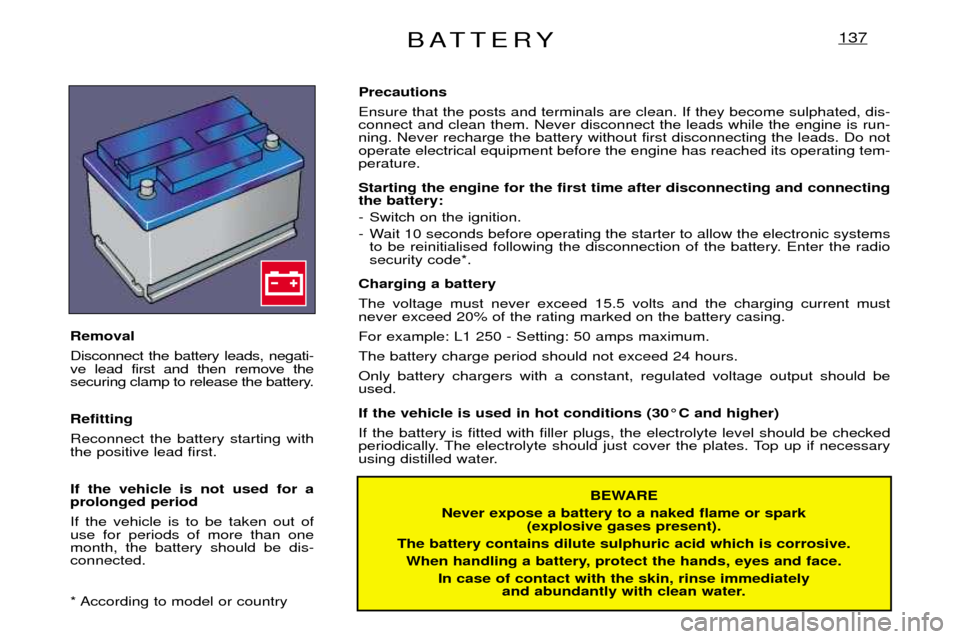Page 55 of 149

CHECKS*77IV-2Beware:When working under the bonnet, the cooling fan could operate if
the engine is hot (even when switched off). The engine oil level should be checked frequently between services (as recommended by the manufacturer), as well as before long journeys.
Priming pump Refer to the section Ç Diesel injection equipment È. Coolant The level should be bet- ween the maximum andminimum marks on the
reservoir. If the engine is hot, wait 15 minutes.Oil quality: see Ç Lubricants and
fluids È. Never work on the cooling sys- tem if the engine is hot. (see
Ç Levels È).
Windscreen, rear screenand headlamp washerfluid It is recommended to use
manufacturer approved products.
12 volt batterySee Ç Emergency starting with a slave battery È. Engine oil Check with the vehicle on level ground, and the
engine off for at least
10 minutes. Level: see Ç Levels È.
Oil quality: see Ç Lubricants and
fluids È.
Take out the oil dipstick.The level must be bet- ween the MAX and MINmarks on the dipstick.
It must not exceed
the maximum mark. Brake fluid The level should be bet- ween the maximum andminimum marks on the
reservoir. Level: see Ç Levels È.
Oil quality: see Ç Lubricants and
fluids È.
If the warning lamp comes on: stop the vehicle
Power steering oilCheck the level with the
engine switched off. Level: see Ç Levels È.
Oil quality: see Ç Lubricants and
fluids È.
Air filterFollow the recommendations in the maintenance guide.
Max Min
* According to model or country
A
B
Page 57 of 149

CHECKS*79IV-2Beware:When working under the bonnet, the cooling fan could operate if
the engine is hot (even when switched off). The engine oil level should be checked frequently between services (as recommended by the manufacturer), as well as before long journeys.
Air filter Follow the recommenda- tions in the maintenanceguide. Coolant The level should be bet- ween the maximum andminimum marks on the
reservoir. If the engine is hot, wait 15 minutes.Oil quality: see Ç Lubricants and
fluids È. Never work on the cooling sys- tem if the engine is hot. (see
Ç Levels È).
Windscreen, rear screenand headlamp washerfluid It is recommended to use
manufacturer approved products.
12 volt batterySee Ç Emergency starting with a slave battery È. Engine oil Check with the vehicle on level ground, and the
engine off for at least
10 minutes. Level: see Ç Levels È.
Oil quality: see Ç Lubricants and
fluids È.
Take out the oil dipstick.The level must be bet- ween the MAX and MINmarks on the dipstick.
It must not exceed
the maximum mark. Brake fluid The level should be bet- ween the maximum andminimum marks on the
reservoir. Level: see Ç Levels È.
Oil quality: see Ç Lubricants and
fluids È.
If the warning lamp comes on: stop the vehicle
Power steering oilCheck the level with the
engine switched off. Level: see Ç Levels È.
Oil quality: see Ç Lubricants and
fluids È.
MaxMin
* According to model or country
B
Page 60 of 149
LEVELSIV-5
82
Beware: When working under the bonnet, the cooling fan could operate if the engi-
ne is hot (even when switched off).
Power steering oil Check the level with the engine
switched off. The level should be between the maximum
and minimum marks on
the reservoir. Never run the engine without oil in the pump reservoir; the pump willbe severely damaged and couldseize. Oil quality: see Ç Lubricants and
fluids È. Engine oilCheck with the vehicle on level
ground, and the engine off for atleast 10 minutes.
Take out the oil dipstick.The level must be between the MAX
and MIN marks on the dips-
tick. Adding engine oil Remove the dipstick before topping up. Check the level after filling.It must not exceed the maximum mark. The oil level should be topped up between services (up to 0.5 l every600 miles). Screw on the cap before shutting the bonnet. Oil quality:
see Ç Lubricants and
fluids È.
Page 61 of 149

LEVELS83IV-5
Beware: When working under the bonnet, the cooling fan could operate if the engi-
ne is hot (even when switched off).
Topping up the cooling system The coolant level should be between the MAXIMUM and MINIMUM marks on the header tank.
Top up the level. If more than I litre is required to top up, have
the cooling system checked by your dealer. Ensure that the cap is fully tightened to the second notch. Note:
Frequent topping up could indicate a fault within the cooling system.
Have it checked as soon as possible.The replacement of the coolant must be carried out by the dealer network. Coolant The antifreeze in the coolant protects against low temperatures and provides anti-corrosion protection and resistance to high operating temperatures.However these properties degrade progressively with time. Oil quality: see Ç Lubricants and fluids È.
Radiator - coolantThe coolant must only be checked or topped up if the engine is cold. Engine hot:
Wait 15 minutes or until the tempe- rature is below 100 degrees C.Using a cloth to protect your hands,slowly slacken the filler cap as far
as the safety catch. Allow the pres-sure to reduce before removingfiller cap.
Page 75 of 149

GEAR LEVER61II-6
Starting position
The engine can only be started
when the lever is at position P or N.
A safety device ensures that starting is impossible in the other positions.
Park Do not engage until the vehicle is completely sta-
tionary. To avoid any
movement of the vehicle when par-ked, select position Pand apply the
handbrake firmly. Check that theselector is in the Pposition to ensure
that the driving wheels are locked. When leaving the vehicle, make
absolutely certain that the PARK orP position is selected.
Automatic gearboxes - safety mea-sures:
¥ The gear lever can only be disen- gaged from position Pif the brake
pedal is pressed down.
¥ An audible warning* sounds if the gear lever is not in position P
when a door is opened. Also works with the ignition switched
off. Reverse gear Engage only when statio- nary and with the footbra-
ke firmly applied. To avoid
any transmission snatch or harsh-ness, wait several seconds before
pressing the accelerator. Neutral Do not select this position,
even momentarily, whenthe vehicle is in motion.
Warning If N is selected inadvertently when the vehicle is moving,allow the vehicle to stop beforeengaging other functions.
* According to model or country
Page 109 of 149

BATTERY137
BEWARE
Never expose a battery to a naked flame or spark (explosive gases present).
The battery contains dilute sulphuric acid which is corrosive. When handling a battery, protect the hands, eyes and face. In case of contact with the skin, rinse immediately and abundantly with clean water.
Removal Disconnect the battery leads, negati- ve lead first and then remove the
securing clamp to release the battery. Refitting Reconnect the battery starting with the positive lead first. If the vehicle is not used for a prolonged period If the vehicle is to be taken out of use for periods of more than onemonth, the battery should be dis-connected.
* According to model or country Precautions Ensure that the posts and terminals are clean. If they become sulphated, dis- connect and clean them. Never disconnect the leads while the engine is run-ning. Never recharge the battery without first disconnecting the leads. Do notoperate electrical equipment before the engine has reached its operating tem-perature. Starting the engine for the first time after disconnecting and connecting the battery:
- Switch on the ignition.
- Wait 10 seconds before operating the starter to allow the electronic systems
to be reinitialised following the disconnection of the battery. Enter the radio security code*.
Charging a battery The voltage must never exceed 15.5 volts and the charging current must never exceed 20% of the rating marked on the battery casing. For example: L1 250 - Setting: 50 amps maximum.The battery charge period should not exceed 24 hours.Only battery chargers with a constant, regulated voltage output should be used. If the vehicle is used in hot conditions (30¡C and higher) If the battery is fitted with filler plugs, the electrolyte level should be checked
periodically. The electrolyte should just cover the plates. Top up if necessary
using distilled water.